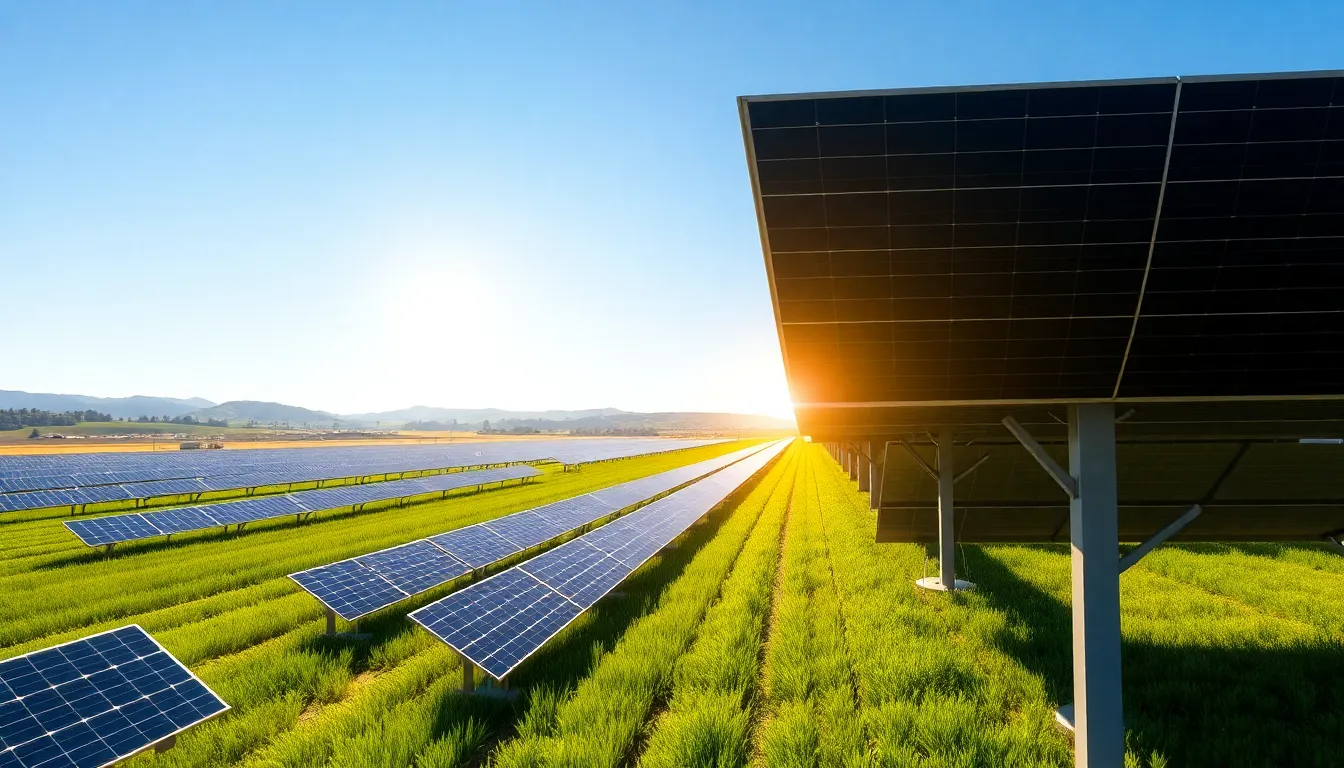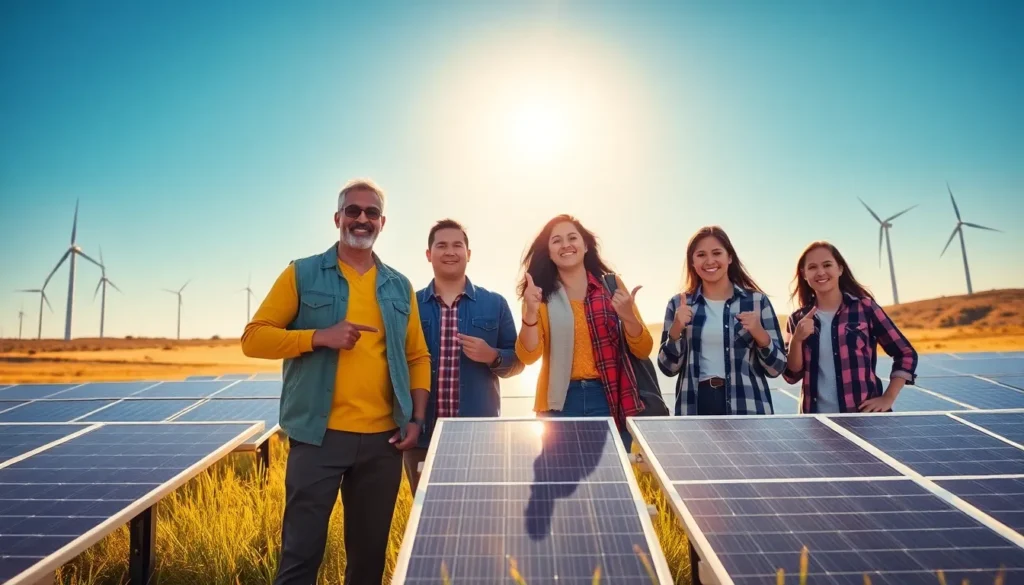In a world where energy consumption skyrockets faster than a cat video goes viral, sustainable energy production is the superhero we didn’t know we needed. Imagine harnessing the power of the sun, wind, and water while giving fossil fuels the boot. It’s not just a dream; it’s a necessity for a greener future and a healthier planet.
As climate change looms like an unwanted houseguest, the shift to renewable energy sources has never been more critical. Not only does sustainable energy help reduce carbon footprints, but it also promises a buffet of benefits—think job creation and energy independence. So, let’s dive into the electrifying world of sustainable energy and discover how it’s paving the way for a brighter, cleaner tomorrow. Who wouldn’t want to be part of that?
Table of Contents
ToggleOverview of Sustainable Energy Production
Sustainable energy production focuses on harnessing renewable resources to meet energy needs without causing environmental harm. Renewable sources, such as solar, wind, hydroelectric, and geothermal power, play a crucial role in this process. These sources reduce reliance on fossil fuels, lowering greenhouse gas emissions and mitigating climate change impacts.
Solar energy captures sunlight through photovoltaic cells or solar thermal systems, providing a clean energy source. Wind energy utilizes turbine systems to convert kinetic energy from wind into electricity. These technologies together support substantial energy generation while minimizing ecological footprints.
Hydropower accounts for about 16% of the world’s electricity supply, making it a significant player in renewable energy production. Utilizing flowing water to spin turbines, this method is both reliable and efficient. Geothermal energy taps into Earth’s internal heat, offering a consistent and stable energy supply.
Transitioning to sustainable energy leads to economic benefits. Reports show that renewable energy sectors create jobs in construction, maintenance, and technology development. Increased investment in sustainable energy infrastructure bolsters local economies and fosters energy independence.
These advancements contribute to overall energy security. Sustainable energy systems can provide a consistent supply of power while lowering exposure to volatile fossil fuel markets. Adopting renewable technologies collectively strengthens resilience against climate-related challenges.
Ultimately, sustainable energy production is fundamental for a cleaner future. Its integration into energy systems worldwide can transform energy consumption patterns and drive global efforts toward environmental sustainability.
Types of Sustainable Energy Sources

Sustainable energy sources play a significant role in reducing environmental impact while fulfilling energy needs. Various types of renewable resources contribute to this movement, each with unique characteristics.
Solar Energy
Solar energy harnesses sunlight through photovoltaic cells or solar thermal systems. This method converts sunlight directly into electricity, providing a clean energy alternative. With advancements in technology, solar panels have become more efficient and affordable. Homes and businesses increasingly invest in solar installations. In 2022, the solar industry provided nearly 250,000 jobs in the U.S., showcasing its ability to drive economic growth.
Wind Energy
Wind energy generates electricity by utilizing turbines that convert kinetic energy from wind. Areas with strong, consistent winds often prove most effective for wind farms. Turbine technology has advanced remarkably, allowing for larger outputs even in lower wind conditions. The U.S. produced around 10% of its electricity from wind in 2022, marking significant progress toward renewable energy targets. Wind energy also fosters local economies, with job creation in turbine manufacturing and maintenance.
Hydropower
Hydropower derives energy from flowing water in rivers or dams. This renewable source consistently provides a stable energy supply and contributes to about 30% of the U.S. renewable energy generation. Projects range from large-scale dams to small run-of-river installations. Hydropower does come with environmental considerations, including impacts on aquatic ecosystems. Nevertheless, it remains a crucial component of a balanced sustainable energy portfolio.
Biomass Energy
Biomass energy converts organic materials, such as wood, agricultural residues, and waste, into heat or electricity. This process reduces landfill waste while producing energy. With proper management, biomass can be sustainable and carbon-neutral. It provides about 5% of total U.S. energy consumption. Projects utilizing waste-to-energy technologies showcase biomass’s potential to transform waste into valuable resources.
Geothermal Energy
Geothermal energy taps into the Earth’s internal heat to generate electricity or provide direct heating. This renewable source is consistently available and operates day and night. The U.S. has substantial geothermal resources, primarily located in the western regions. In 2022, geothermal energy supplied about 0.4% of the nation’s electricity. Its reliability and low emissions underline geothermal’s role in a sustainable energy future.
Benefits of Sustainable Energy Production
Sustainable energy production offers multiple advantages beyond just meeting energy demands. It plays a crucial role in fostering a healthier planet.
Environmental Impact
Transitioning to sustainable energy sources significantly reduces greenhouse gas emissions. Solar, wind, and geothermal energy generate power without the harmful pollutants released by fossil fuels. This reduction in emissions leads to better air quality and a healthier environment. Biodiversity also benefits, as using renewable resources minimizes habitat destruction and pollution. Additionally, sustainable energy technologies promote resource conservation, leading to a lower ecological footprint overall.
Economic Advantages
Economic benefits accompany the shift to sustainable energy production. Job creation increases in various sectors, including manufacturing, installation, and maintenance of renewable energy systems. Investment in these industries promotes local economies and enhances competitiveness on a global scale. Solar and wind sectors alone have generated thousands of new jobs in recent years. Furthermore, the declining costs of renewable technologies attract more investments, stimulating economic growth while fostering innovation.
Energy Security
Sustainable energy enhances energy security by diversifying energy sources. Reducing reliance on imported fossil fuels strengthens local economies and minimizes vulnerability to market fluctuations. Renewable energy infrastructures support a more stable energy supply and help mitigate risks associated with geopolitical tensions. Reliable energy systems ensure consistent access, empowering regions to develop independent energy capabilities. Ultimately, prioritizing sustainable solutions advances resilience and stability in energy frameworks.
Challenges in Sustainable Energy Production
Sustainable energy production faces several challenges that can hinder its widespread implementation. These obstacles include technological limitations, economic barriers, and policy and regulation issues.
Technological Limitations
Technological advancements drive sustainable energy production, yet significant limitations exist. Solar panels require more efficient designs for increased energy conversion rates. Wind turbines need better energy storage solutions to manage fluctuations in wind speed. Hydropower systems often confront environmental concerns that can compromise development. Innovating sustainable technologies focuses on improving efficiency while reducing costs, paving the way for a more robust transition.
Economic Barriers
Economic factors consistently present barriers to sustainable energy initiatives. Higher initial investments deter many businesses and consumers from adopting renewable technologies. Funding opportunities for sustainable projects often lack availability or accessibility, slowing down potential growth. Inconsistent energy prices also complicate long-term investments in renewable energy. Addressing these economic challenges requires strategic partnerships, innovative financing methods, and government incentives to encourage growth in the sector.
Policy and Regulation
Policy and regulation play vital roles in shaping the landscape of sustainable energy production. Existing laws may pose obstacles, creating a patchwork of incentives and disincentives that hinder development. Regulatory frameworks often lag behind technological advancements, causing uncertainty for investors. Streamlined policies and clear guidelines will foster a more predictable environment for renewable energy growth. Promoting collaborative efforts among governments, industries, and communities can create policies that accelerate sustainable energy initiatives.
Sustainable energy production stands as a crucial pillar for a cleaner and healthier future. By embracing renewable resources like solar, wind, and hydropower, society can significantly reduce its carbon footprint while fostering economic growth. The transition to these energy sources not only addresses climate change but also enhances energy security and independence.
As technological advancements continue to evolve, overcoming existing barriers will be vital for widespread adoption. With strategic partnerships and innovative financing, the path toward sustainable energy can be accelerated. Ultimately, the commitment to sustainable energy production will shape a resilient and environmentally friendly energy landscape for generations to come.




